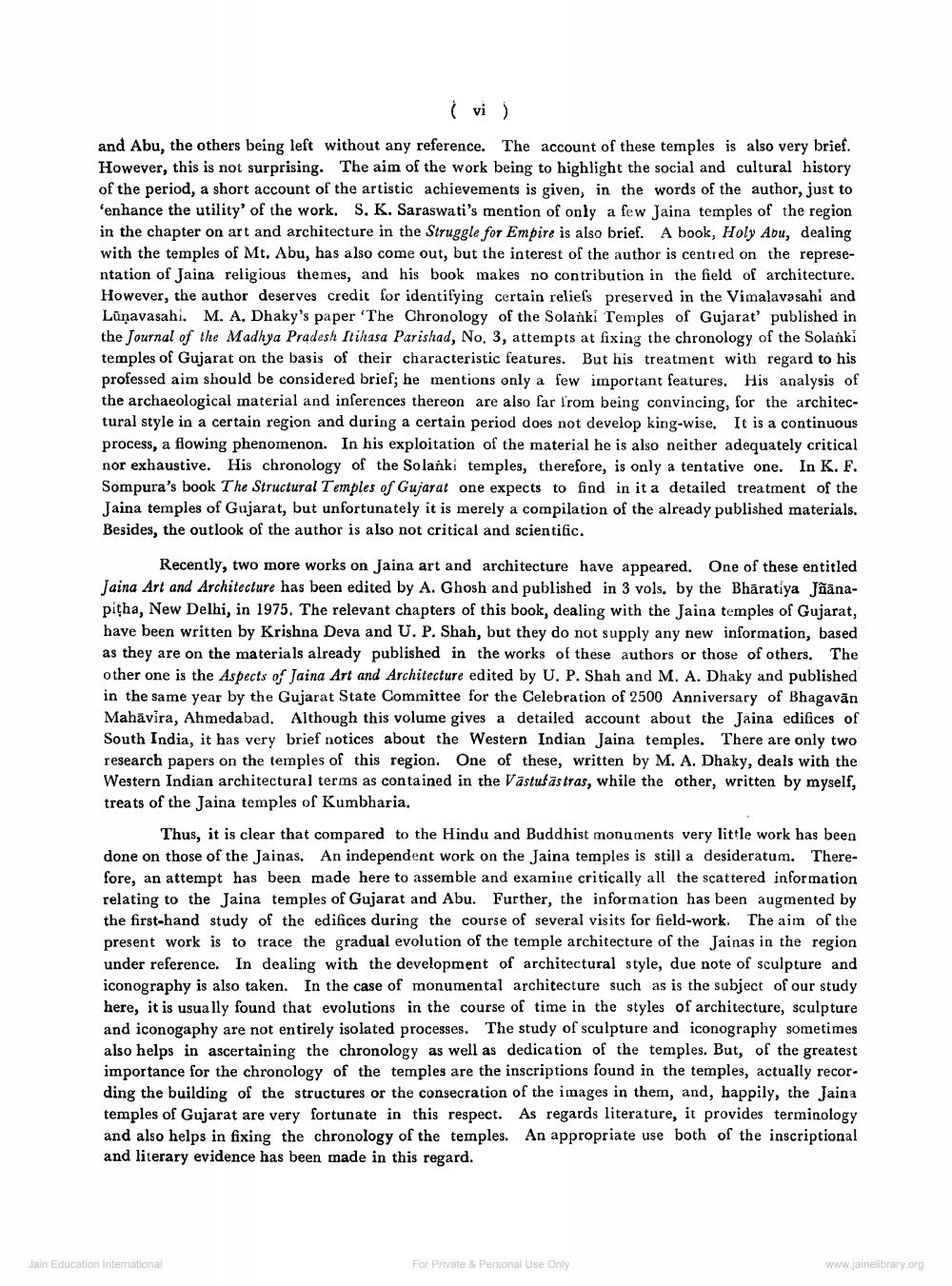Book Title: Jaina Temples of Western India Author(s): Harihar Singh Publisher: P V Research Institute Varanasi View full book textPage 7
________________ (vi) and Abu, the others being left without any reference. The account of these temples is also very brief. However, this is not surprising. The aim of the work being to highlight the social and cultural history of the period, a short account of the artistic achievements is given, in the words of the author, just to 'enhance the utility' of the work. S. K. Saraswati's mention of only a few Jaina temples of the region in the chapter on art and architecture in the Struggle for Empire is also brief. A book, Holy Abu, dealing with the temples of Mt, Abu, has also come out, but the interest of the author is centred on the representation of Jaina religious themes, and his book makes no contribution in the field of architecture. However, the author deserves credit for identifying certain reliefs preserved in the Vimalavasahi and Lūņavasahi. M. A. Dhaky's paper 'The Chronology of the Solanki Temples of Gujarat' published in the Journal of the Madhya Pradesh Itihasa Parishad, No. 3, attempts at fixing the chronology of the Solanki temples of Gujarat on the basis of their characteristic features. But his treatment with regard to his professed aim should be considered brief; he mentions only a few important features. His analysis of the archaeological material and inferences thereon are also far from being convincing, for the architectural style in a certain region and during a certain period does not develop king-wise. It is a continuous process, a flowing phenomenon. In his exploitation of the material he is also neither adequately critical nor exhaustive. His chronology of the Solanki temples, therefore, is only a tentative one. In K. F. Sompura's book The Structural Temples of Gujarat one expects to find in it a detailed treatment of the Jaina temples of Gujarat, but unfortunately it is merely a compilation of the already published materials. Besides, the outlook of the author is also not critical and scientific. Recently, two more works on Jaina art and architecture have appeared. One of these entitled Jaina Art and Architecture has been edited by A. Ghosh and published in 3 vols. by the Bhāratiya Jõānapitha, New Delhi, in 1975. The relevant chapters of this book, dealing with the Jaina temples of Gujarat, have been written by Krishna Deva and U. P. Shah, but they do not supply any new information, based as they are on the materials already published in the works of these authors or those of others. The other one is the Aspects of Jaina Art and Architecture edited by U. P. Shah and M. A. Dhaky and published in the same year by the Gujarat State Committee for the Celebration of 2500 Anniversary of Bhagavān Mahāvira, Ahmedabad. Although this volume gives a detailed account about the Jaina edifices of South India, it has very brief notices about the Western Indian Jaina temples. There are only two research papers on the temples of this region. One of these, written by M. A. Dhaky, deals with the Western Indian architectural terms as contained in the Vastufas tras, while the other, written by myself, treats of the Jaina temples of Kumbharia. Thus, it is clear that compared to the Hindu and Buddhist monuments very little work has been done on those of the Jainas. An independent work on the Jaina temples is still a desideratum. Therefore, an attempt has been made here to assemble and examine critically all the scattered information relating to the Jaina temples of Gujarat and Abu. Further, the information has been augmented by the first-hand study of the edifices during the course of several visits for field-work. The aim of the present work is to trace the gradual evolution of the temple architecture of the Jainas in the region under reference. In dealing with the development of architectural style, due note of sculpture and iconography is also taken. In the case of monumental architecture such as is the subject of our study here, it is usually found that evolutions in the course of time in the styles of architecture, sculpture and iconogaphy are not entirely isolated processes. The study of sculpture and iconography sometimes also helps in ascertaining the chronology as well as dedication of the temples. But, of the greatest importance for the chronology of the temples are the inscriptions found in the temples, actually recording the building of the structures or the consecration of the images in them, and, happily, the Jaina temples of Gujarat are very fortunate in this respect. As regards literature, it provides terminology and also helps in fixing the chronology of the temples. An appropriate use both of the inscriptional and literary evidence has been made in this regard. Jain Education International For Private & Personal use only www.jainelibrary.orgPage Navigation
1 ... 5 6 7 8 9 10 11 12 13 14 15 16 17 18 19 20 21 22 23 24 25 26 27 28 29 30 31 32 33 34 35 36 37 38 39 40 41 42 43 44 45 46 47 48 49 50 51 52 53 54 55 56 57 58 59 60 61 62 63 64 65 66 67 68 69 70 71 72 ... 362
